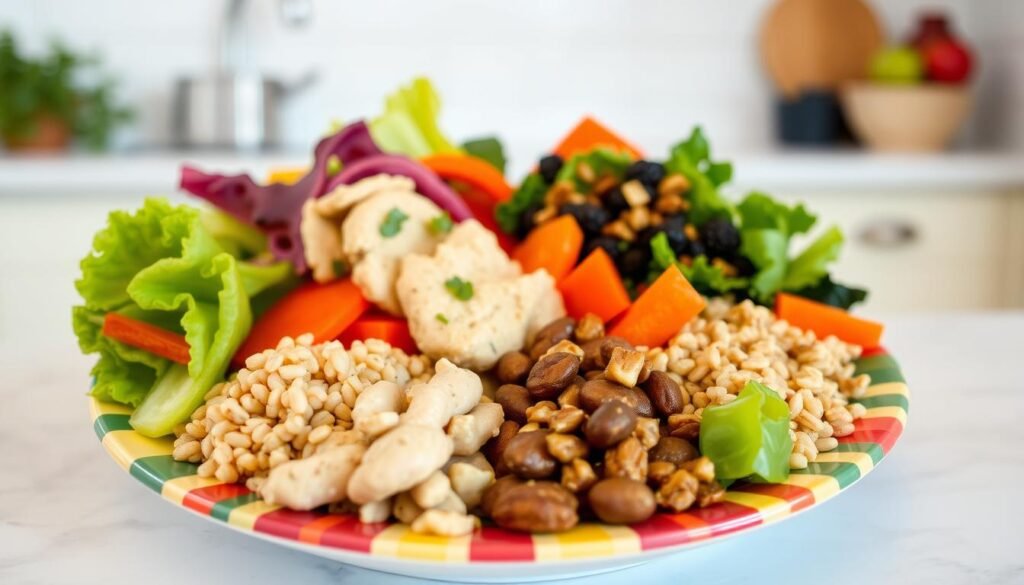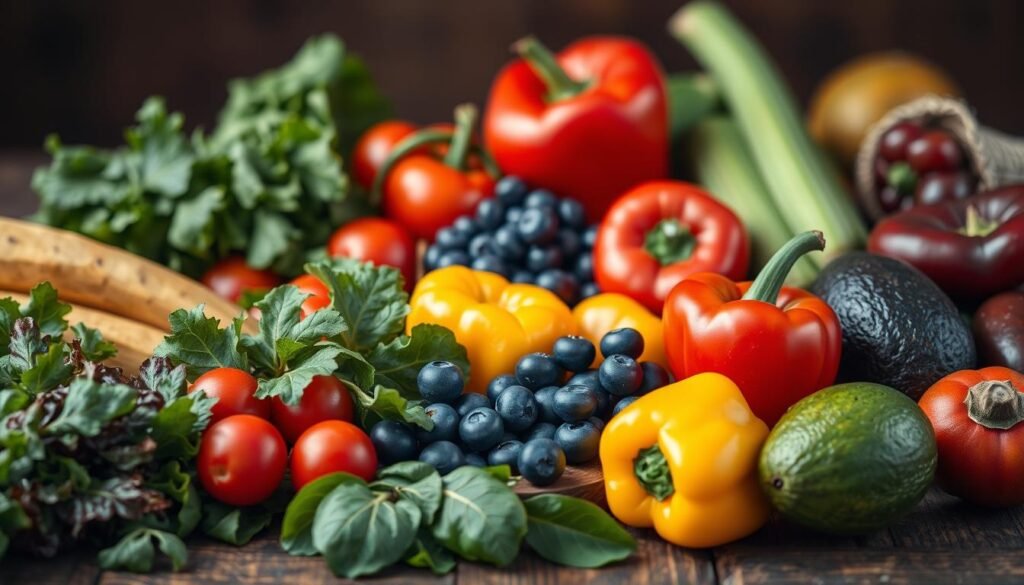In the busy world we live in, it’s crucial to eat healthily. Good nutrition keeps our diet balanced, improving our health and happiness. When we choose our food wisely, we feel more alive and full of energy.
Advice from the Dietary Guidelines for Americas and the World Health Organization shows us how. Learning about nutrition can lead to better health choices. Let’s dive into what makes eating healthy so important for a lively life.
Table of Contents
ToggleKey Takeaways
- Healthy eating is essential for overall well-being.
- A balanced diet promotes vitality and energy levels.
- Understanding nutrition helps in making informed choices.
- Guidelines from reputable organizations support healthy eating habits.
- Food choices impact health and quality of life.
Understanding Nutrition Basics
Nutrition is key to our well-being. It’s about how our bodies use food for energy, growth, and staying healthy. Understanding nutrition lets us choose our foods wisely. This leads to better health.
What is Nutrition?
Nutrition involves the body’s processes for using food. This includes eating, absorbing, and applying food for nourishment. Whether young or old, good nutrition is crucial. It aids in growth and supports a strong immune system.
Macronutrients vs. Micronutrients
There are two kinds of nutrients in nutrition: macronutrients and micronutrients. They have different roles.
- Macronutrients: Needed in big amounts by the body, they include:
- Carbohydrates: The main source of energy for us.
- Proteins: Vital for fixing and building muscles.
- Fats: They help in balancing hormones and absorbing nutrients.
- Micronutrients: Important vitamins and minerals needed in small amounts. They support many body functions. These include:
- Vitamins: Like vitamin C, crucial for the immune system.
- Minerals: Like calcium, vital for strong bones.
Knowing how much of each nutrient to eat is important. Following the USDA’s advice helps keep our diet balanced. Making good nutrition a priority improves our physical and mental health.
Healthy Eating: Key Principles
Healthy eating is the base of a good lifestyle. Knowing how important a balanced diet is matters for well-being. It includes many food types, giving you the nutrients you need for health.
Importance of a Balanced Diet
A balanced diet is key to staying healthy and avoiding long-term illnesses. It involves eating the right amounts from different groups, such as:
- Fruits
- Vegetables
- Whole grains
- Proteins
- Dairy
Tools like MyPlate make eating right easier. It helps with choosing food, managing portions, and eating varied meals every day. Eating well helps prevent diseases, manages your weight, and keeps your energy up. If you are looking for the best Website, you can visit here for more information: Diet Pills
Components of Healthy Eating
Nutrition’s parts are like the blocks for a healthy diet. Knowing them makes sure your meals are good for you. These parts are:
- Carbohydrates – They give you energy and help your body work.
- Proteins – Important for growth, fixing damage, and cell health.
- Fats – Needed for making hormones and vitamin absorption.
- Vitamins and Minerals – They’re key for body processes.
- Water – Keeps you hydrated and your body running smoothly.
Making smart choices about these helps your health for years. By focusing on these, you get to explore tasty and diverse foods while staying healthy.
The Benefits of Clean Eating
Embracing clean eating means choosing whole, minimally processed foods. This method offers numerous benefits for your well-being. People often enjoy more energy, a better mood, and clearer thinking.
Improved Energy Levels
Switching to clean eating can boost your energy. Eating fresh fruits, veggies, whole grains, and quality proteins helps. These foods provide essential nutrients for steady energy, unlike sugary, processed snacks.
Better Mood and Mental Clarity
Clean eating does wonders for your mind and emotions. Whole foods improve mood and clarity, research says. They lack the unhealthy fats and sugars that cause energy dips and mood swings. With clean eating, you’re likely to feel emotionally stronger and more focused.
Incorporating Whole Foods into Your Diet
Whole foods are key to eating well. They give you the nutrients you need without unwanted extras. These foods are not processed much, which is great for anyone wanting to eat better. Knowing about whole foods and adding them to your meals helps you stay nutritious.
What Are Whole Foods?
Whole foods are as close to their natural form as possible. Think fruits, veggies, grains, nuts, and beans. They keep their nutritional goodness and don’t have artificial stuff. Eating more whole foods can boost your health.
How to Choose Whole Foods
There are smart ways to pick whole foods when you shop:
- Shop the perimeter of grocery stores, where fresh produce and whole foods are typically located.
- Opt for seasonal produce to ensure freshness and flavor.
- Check food labels carefully. Look for items with minimal ingredients and avoid added sugars and preservatives.
Examples of Whole Foods to Include
Adding different whole foods to your diet makes eating healthy easier. Try these options:
- Fruits: Apples, bananas, berries, and oranges provide vitamins and antioxidants.
- Vegetables: Leafy greens, broccoli, carrots, and peppers are high in nutrients and fiber.
- Whole Grains: Brown rice, quinoa, oats, and barley are excellent sources of carbohydrates and fiber.
- Nuts and Seeds: Almonds, walnuts, chia seeds, and flaxseeds offer healthy fats and protein.
- Legumes: Beans, lentils, and peas are rich in protein and essential minerals.
Exploring Plant-Based Diet Options
Switching to a plant-based diet has many benefits for your health and the planet. Eating more veggies and fruits is good for you. This way of eating is great for your body and the environment.
It’s full of fruits, veggies, and beans. These foods are great for your health. Many people like this diet because it makes them feel good.
Health Benefits of Plant-Based Eating
Studies show eating more plants is healthy. People who eat this way often see great health results. They have:
- Reduced risk of heart disease: Eating more plants can make your heart healthier.
- Lower incidence of diabetes: Foods like whole grains keep your blood sugar steady.
- Decreased risk of certain cancers: Fruits and veggies help fight cancer.
Common Plant-Based Foods
Eating plant-based is easy and fun. Make sure to eat a variety of foods like:
- Fruits: Enjoy berries, bananas, apples, and oranges.
- Vegetables: Eat plenty of greens, peppers, carrots, and broccoli.
- Legumes: Beans and lentils are great for protein.
- Nuts and Seeds: Nuts like almonds add good fats to your diet.
- Whole Grains: Foods like quinoa are full of fiber.
Mastering Portion Control
Grasping portion control can greatly boost your health. It’s key to eating right and avoiding too much food. By learning about portion sizes, people can choose their food wisely. This helps with keeping a good weight or even losing some.
Understanding Serving Sizes
Knowing about serving sizes is crucial for portion control. Knowing what a healthy portion looks like is important. For instance, one cup is enough for pasta, and three ounces is just right for chicken. Look at the table below for more examples:
| Food Item | Recommended Serving Size |
|---|---|
| Pasta | 1 cup cooked |
| Rice | 1 cup cooked |
| Chicken Breast | 3 ounces |
| Fruit (like apples) | 1 medium apple |
| Vegetables (like broccoli) | 1 cup raw |
Tips for Proper Portioning
To manage your portions, follow these helpful tips:
- Use smaller plates: This can make you feel like you’re eating more than you are.
- Measure servings: Doing this often helps you get used to standard amounts.
- Be mindful at restaurants: Sharing meals or boxing half for later can control portions.
- Keep healthy snacks handy: Fruits and veggies are great for snack portion control.

The Art of Meal Planning
Meal planning is key to eating healthy. It makes daily cooking easy and promotes good food choices. Spending a bit of time planning meals leads to a healthier way of life.
Benefits of Meal Planning
Meal planning has lots of perks:
- Saves Time: Make meals in advance to ease your week.
- Reduces Food Waste: Planning helps use ingredients before they go bad.
- Encourages Healthy Meals: Picking healthy recipes ahead means better eating.
- Controls Portions: It aids in portion control for weight management.
How to Create a Meal Plan
Starting a meal plan is easy. Just follow these steps:
- Select Recipes: Pick a variety of meals you like.
- Make a Grocery List: List all ingredients you need, choosing fresh and seasonal items.
- Schedule Cooking Days: Set aside time for meal prep, maybe on weekends.
- Store Meals Properly: Keep them in containers to stay fresh in the fridge or freezer.
Meal Prep Ideas to Save Time
Try these meal prep ideas to streamline your planning:
- Batch Cooking: Cook big meals like soups for the week.
- Easy Snack Preparations: Prep veggies or portion nuts for quick snacks.
- Freezer-Friendly Meals: Make meals to freeze for busy days.
Practicing Mindful Eating
Mindful eating helps people connect deeply with their food choices. It leads to an awareness of when you’re hungry or full. It also lets you enjoy every bite more. Paying attention to what you eat makes you more in tune with your body’s needs and the joy of eating.
What is Mindful Eating?
Mindful eating means being fully present when you eat. It helps you notice why and how you eat. This awareness helps you understand the link between emotions and eating. By paying close attention to your food’s taste, texture, and smell, you’ll enjoy your meals more. This can lead to a healthier way of eating.
Techniques for Mindful Eating
Using mindful eating techniques can make eating a better experience. Here are some tips:
- Slow down: Chew your food well to fully taste and enjoy it.
- Remove distractions: Turn off the TV and put your gadgets aside. Concentrate on your meal for better awareness.
- Savor the flavors: Notice the taste, smell, and feel of your food to enjoy it more.
- Listen to your body: Pay attention to hunger and fullness signs. Stop eating when you feel just right.
Practicing these techniques leads to more mindful nourishment. It improves your mealtime and can help with better eating habits and managing your weight.
Common Myths about Healthy Eating
There are many wrong ideas about what’s healthy to eat. It’s important to know the truth about nutrition myths. We’ll clear up the confusion about healthy eating here. Plus, learning to read food labels helps you pick truly healthy foods.
Debunking Popular Nutrition Myths
Some people believe things about food that can lead them away from healthy choices. Here are some myths:
- Carbohydrates are bad: Some think carbs cause weight gain, but whole grains and fruits are good for you.
- All fats are unhealthy: Actually, foods like avocados and nuts have fats that are good for your health.
- Protein must come from meat: Beans and legumes are also great sources of protein.
Understanding Food Labels
Reading food labels is a key skill for healthy eating. They tell you what’s in your food. Here’s a guide to some terms on those labels:
| Term | What It Means |
|---|---|
| Organic | Made without synthetic fertilizers and pesticides. |
| Low-Fat | Has under 3 grams of fat per serving. |
| Gluten-Free | Free from ingredients from wheat, barley, or rye. |
| No Added Sugar | Free from extra sugars added during processing. |
Having this knowledge lets people make better choices every day. Knowing what nutrition myths are false and how to read food labels leads to healthier living.

Finding Balance in Your Diet
A balanced diet is key to feeling great. It means enjoying food in a smart way. It’s about blending nutrition with the foods you love.
Adding healthy treats can make eating fun without losing sight of your goals. Indulging the right way keeps you on track.
How to Enjoy Treats Responsibly
Even treats can fit into a healthy diet. The secret? Balance and being mindful. Let’s go over some advice:
- Practice mindful eating: Be aware of your eating. Relish each mouthful.
- Portion control: Have smaller amounts of the foods you adore.
- Choose healthier alternatives: Pick snacks with natural ingredients.
- Incorporate balance: Mix treats with healthier options for diet balance.
Creating a Sustainable Eating Plan
Creating a lasting healthy eating habit is vital. Here’s what to include:
- Diverse food selection: Enjoy many types of whole foods from each group.
- Meal prep: Planning meals in advance helps resist junk food.
- Flexible frameworks: It’s okay to have an occasional treat. No guilt needed.
Blending these ideas will improve your food relationship. It leads to a balanced diet and happy snacking. Always aim for balance and health.
| Food Category | Healthy Options | Healthy Treats |
|---|---|---|
| Fruits | Apples, Berries | Dried Fruit Bars |
| Grains | Whole Wheat Bread, Quinoa | Granola Clusters |
| Dairy | Greek Yogurt, Almond Milk | Yogurt Parfaits |
| Proteins | Chicken, Lentils | Protein Cookies |
Conclusion
Starting a journey toward healthy eating is a big step towards a balanced life. This guide has shown the key parts of a healthy diet. It has stressed the importance of whole foods, portion control, and making smart food choices.
The perks of clean eating, like more energy, better mood, and a fuller life, are clear. Let’s not forget, small changes can make a big difference in our health. By following this article’s advice, we can slowly build habits for better nutrition.
Think about how you can use these tips every day. Healthy eating is not about being perfect. It’s about finding a good balance and being flexible. Keep learning and adjusting, and you will see how a healthy lifestyle is both possible and rewarding.
FAQ
What is healthy eating?
Healthy eating means choosing foods that are good for you. It’s about eating a mix of nutritious foods. Foods like fruits, veggies, whole grains, proteins, and healthy fats are key for balanced eating.
How can I plan meals for a balanced diet?
Planning balanced meals means including different food groups. Aim to have fruits, veggies, proteins, and whole grains in each meal. Using a calendar to organize meals helps ensure nutritional variety.
What are some tips for practicing portion control?
For portion control, use smaller plates and measure servings. Pay attention to how much you’re eating. It helps avoid eating too much and supports your nutrition goals.
How do I incorporate whole foods into my diet?
Choose foods that are unprocessed or barely processed. Shop for fresh items like produce, grains, nuts, and beans. Always check labels to steer clear of added sugars and preservatives.
What are the health benefits of a plant-based diet?
Eating plant-based can lower the risk of heart disease, diabetes, and some cancers. This diet focuses on vegetables, legumes, nuts, seeds, and grains. These foods are full of nutrients and promote health.
What is mindful eating, and how can it help me?
Mindful eating means being fully present while eating. Listen to your hunger signs and enjoy your food. It helps you become more aware of your eating habits, manage your weight, and enjoy a better relationship with food.
How can I debunk common myths about healthy eating?
To fight nutrition myths, trust credible information and research. Understand that not all carbs are bad; whole grains are important. Learning to interpret food labels can also guide you towards healthier choices.
What are some strategies for enjoying treats responsibly?
Balance is important when it comes to treats. Choose smaller amounts of sweets and combine them with healthy meals. Having a plan that includes treats sometimes makes it easier to keep up a healthy diet.
How can I make a meal plan that supports healthy eating?
Start with choosing a variety of whole foods for your meal plan. Preparing meals in advance saves time and reduces waste. It helps you stay on track with eating well.













